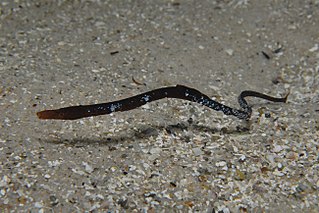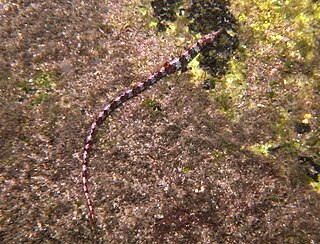
Schultz's pipefish, Corythoichthys schultzi, is a pipefish of the family Syngnathidae.
Lissocampus bannwarthi is a species of marine pipefish belonging to the family Syngnathidae.
Lissocampus caudalis, also called the Australian smooth pipefish or the smooth pipefish, is a species of marine fish belonging to the family Sygnathidae.

Histiogamphelus briggsii, also known as Brigg's pipefish, is a species of marine fish in the family Sygnathidae. It can be found in the shallow waters surrounding South Australia, New South Wales, and Northern Tasmania. Its habitat can consist of reefs, seagrass beds, and sandy beach and estuarine environments Individuals of this species can grow to lengths of 25 cm (9.8 in). They are an ovoviviparous species, in which males brood eggs and give birth to live young.
Ichthyocampus carce, also known as the freshwater pipefish or Indian freshwater pipefish is a species of marine fish belonging to the family Syngnathidae. It can be found mainly in freshwater streams, rivers, and estuaries located in the Indian Ocean and West Pacific, from Indonesia to the western coast of India. It can live in both inland and coastal waters. This species can grow to a length of 15cm and feeds primarily on small invertebrates and zooplankton. Reproduction occurs through ovoviviparity, in which the males carry eggs in a brood pouch before giving live birth. Males of this species can brood roughly 280 offspring at a time.
Hypselognathus rostratus, also known as the knife-snouted pipefish is a species of marine fish belonging to the family Syngnathidae. This species can be found in very shallow coastal waters of southeastern Australia. Their habitat consists of sandy substrates, seagrass beds, and estuaries. Reproduction occurs through ovoviviparity in which the males brood eggs before giving live birth.
Lissocampus filum, also known as the shortsnout pipefish, is a species of marine fish belonging to the family Syngnathidae. This species can be found in tidepools, algae beds, and estuaries in the coastal region surrounding New Zealand and the Chatham Islands. Its diet is thought to consist of small crustaceans such as copepods. The yellow-eyed penguin has been recorded as a predator of Lissocampus filum. Reproduction occurs through ovoviviparity in which the males brood eggs before giving live birth.

Lissocampus runa, also known as the javelin pipefish is a species of marine fish belonging to the family Syngnathidae. This species can be found in algae beds, rocky reefs, tidepools, and estuaries along the coast of southern Australia from Broken Head Nature Reserve in New South Wales to Rottnest Island, Western Australia. Their diet is thought to consist of small crustaceans such as copepods .Reproduction occurs through ovoviviparity in which the males brood eggs before giving live birth.
Maroubra perserrata, also known as the sawtooth pipefish is a species of marine fish belonging to the family Syngnathidae. This species can be found at depths up to 20 meters along the coast of Australia from southern Queensland to southern Western Australia. While they can live in many different habitats, they are often found inhabiting openings in reefs and rocks that contain algae and invertebrates, which they likely rely on for camouflage. Reproduction occurs through ovoviviparity in which the males brood eggs for roughly 22 days before giving live birth. Maroubra perserrata is considered more mobile than many pipefish species due to its prehensile tail and reduced caudal fin.
Phoxocampus belcheri, also known as the rock pipefish, is a species of marine fish belonging to the family Syngnathidae. The species can be found in shallow reefs and tide pools throughout much of the Indo-Pacific ranging from the eastern coast of Africa and the Red Sea to Tonga and Japan. Its diet likely consists of small crustaceans such as copepods. Reproduction occurs through ovoviviparity in which the males brood eggs before giving live birth.
Phoxocampus diacanthus, also known as the obscure pipefish or spined pipefish, is a species of marine fish belonging to the family Sygnathidae. It can be found inhabiting reefs throughout the Indo-Pacific from Japan and Sri Lanka to Samoa and New Caledonia in the south. Its diet likely consists of small crustaceans. Reproduction occurs through ovoviviparity in which the males brood eggs before giving live birth.
Phoxocampus tetrophthalmus, also known as the trunk-barred pipefish is a species of marine fish belonging to the family Syngnathidae. This species can be found in reefs and tide pools of the Indo-Pacific specifically Indonesia, the Philippines, and Guam. They have also been observed in the Andaman, Cocos-Keeling, and Ryukyu islands. Their diet likely consists of small crustaceans Reproduction occurs through ovoviviparity in which the males brood eggs before giving live birth.
Stigmatopora nigra, also known as the wide-bodied pipefish is a species of marine fish belonging to the family Syngnathidae. This species can be found in the shallow waters, bays, and estuaries of southern Australia from Shark Bay to Brisbane, Tasmania, and New Zealand. They often inhabit seagrass or algae beds in addition to bare sand. Their diet consists of small crustaceans such as copepods and amphipods. Adult brooding males have been measured at 6.5-7 centimeters. Reproduction occurs through ovoviviparity. in which the males brood up to 25 eggs in a pouch below the tail before giving live birth. Stigmatopora nigra can live to 150 days old and are able to reproduce throughout the year.

Trachyrhamphus bicoarctatus, also known as the double-ended pipefish is a species of marine fish belonging to the family Syngnathidae. They can be found in reefs, seagrass beds, and sandy habitats throughout the Indo-Pacific from East Africa to New Caledonia and from Japan to Australia. Males of this species are considered mature when they reach approximately 26 centimeters long, but adults can grow to be lengths of 40 centimeters. Reproduction occurs through ovoviviparity in which males brood eggs before giving live birth.
Trachyrhamphus longirostris, also known as the long-head pipefish or straightstick pipefish, is a species of marine fish belonging to the family Syngnathidae. They can be found in muddy estuaries on the continental shelf throughout the Indo-Pacific from Eastern Africa to the Solomon Islands and Japan. The diet of Trachyrhamphus longirostris likely consists of small crustaceans. Adult individuals can grow to be approximately 33 centimeters in length. Reproduction occurs through ovoviviparity in which males brood eggs before giving live birth.
Pseudophallus mindii, also known as the freshwater pipefish is a species of marine fish belonging to the family Syngnathidae. They can be found in freshwater coastal rivers and mangrove estuaries ranging from Belize to Brazil. Members of this species can grow to lengths of 16 cm and their diet likely consists of small crustaceans. Reproduction occurs through ovoviviparity in which the males brood eggs before giving live birth.
Nannocampus subosseus, also known as the bony-headed pipefish is a species of marine fish belonging to the family Syngnathidae. They can be found inhabiting reefs and tide pools only in the region of Shark Bay to Esperance, Western Australia. Members of this species can grow to lengths of 12 cm and their diet likely consists of small crustaceans such as copepods. Reproduction occurs through ovoviviparity in which the males brood eggs before giving live birth.
Nannocampus weberi, also known as the reef-flat pipefish is a species of marine fish belonging to the family Syngnathidae. They can be found inhabiting reefs in the Lesser Sunda Islands of Indonesia particularly the islands of Sumba and Bali. Their diet likely consists of small crustaceans such as copepods. Reproduction occurs through ovoviviparity in which the males brood eggs before giving live birth.
Vanacampus margaritifer, also known as the mother-of-pearl pipefish is a species of marine fish belonging to the family Syngnathidae. They can be found inhabiting seaweed and seagrass beds in addition to rocky reefs along the southern and eastern coast of Australia from Brisbane to Perth. Their diet likely consists of small crustaceans. Reproduction occurs through ovoviviparity in which the males brood eggs before giving live birth.

Vanacampus vercoi, also known as Verco's pipefish is a species of marine fish belonging to the family Syngnathidae. They can be found inhabiting seaweed and seagrass beds in addition to tidepools at depths between 2–4 meters from Spencer's Gulf to Encounter Bay, South Australia. Their diet likely consists of small crustaceans such as amphipods and copepods. Reproduction occurs through ovoviviparity in which the males brood eggs before giving live birth.





